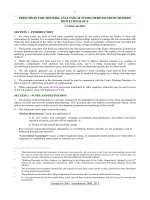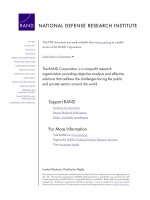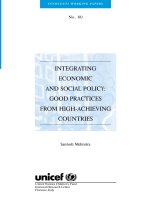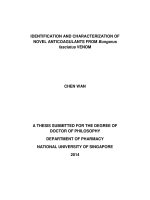Polyimides modifications and carbon molecular sieves derived from polyimides for gas separation
Bạn đang xem bản rút gọn của tài liệu. Xem và tải ngay bản đầy đủ của tài liệu tại đây (2.54 MB, 225 trang )
POLYIMIDES MODIFICATIONS AND CARBON
MOLECULAR SIEVES DERIVED FROM
POLYIMIDES FOR GAS SEPARATION
Shao Lu
(M.Sc. HIT)
A Dissertation Submitted for the Degree of Doctor of
Philosophy
Department of Chemistry
National University of Singapore
2005
Polyimides Modifications and Carbon Molecular Sieves Derived from Polyimides for Gas Separation Shao Lu
ACKNOWLEDGEMENT
I would like to thank all whose who have provided me the guidance and support on my
path route to complete the Ph.D. thesis. First of all, I am very grateful to Prof. Neal
Chung Tai-Shung, Prof. Goh Suat Hong and Dr. Pramoda Kumari Pallathadka for their
enlightening instructions not only on academic aspect but on the personal character
shaping.
Many thanks to Dr. Glen Wensley for supplying me the raw materials. Special thanks
are due to Dr. Liu Ye for providing me the materials for my research and Dr. Chao
Chun for his useful help to direct me in my initial research work.
I would like to acknowledge the financial support from the A*Star and NUS with the
grant numbers of R-279-000-113-304 and R-279-000-108-112.
I thank all the people for their suggestions including Dr. Li Dong Fei, Dr. Li Xue Dong,
Dr. Goh Ho Wee, Dr. Huang Xu Dong, Miss Teo May May, Miss Shi Meng, Miss Tin
Pei Shi, Miss Wang Yan, Miss Chng Mei Lin, Miss Guo Wei Fen, Miss Jiang Lanying,
Miss Qiao Xiang Yi, Mr. Zhou Chun, Mr Xiao You Chang, Mr. Xiong Jun Ying, Mr
Wang Kai Yu, Mr. Li Yi, and Mr. Liu Rui Xue. I would also extend my thanks and
appreciation to my other friends in IMRE and NUS.
No doubt, the unconditional love from my family provides me the strongest moral
i
Polyimides Modifications and Carbon Molecular Sieves Derived from Polyimides for Gas Separation Shao Lu
support to pursue my academic achievement. I would like share in the accomplishment
with my family, who make it meaningful.
ii
Polyimides Modifications and Carbon Molecular Sieves Derived from Polyimides for Gas Separation Shao Lu
TABLE OF CONTENTS
ACKNOWLEGEMENT
TABLE OF CONTENTS
SUMMARY
NOMENCLATURE
LIST OF TABLES
LIST OF FIGURES
CHAPTER 1 INTRODUCTION AND OVERVIEW
1.1 Membranes for Gas Separation
1.1.1 Membrane definition and history review
1.1.2 Polymeric membrane materials
1.1.3 Equilibrium state in rubbery polymers and non-equilibrium state in glassy
polymers
i
iii
xi
xiv
xviii
xx
1
1
3
5
7
8
9
9
9
10
12
12
13
1.1.4 Plasticization phenomena in glassy polymers
1.2 Polyimide as Membrane Materials for Gas Separation
1.3 Polyimide Modification
1.3.1 Thermal modification
1.3.2 UV modification
1.3.3 Ion beam modification
1.3.4 Interpenetrating networks (IPNs)
1.3.5 Chemical modification
iii
Polyimides Modifications and Carbon Molecular Sieves Derived from Polyimides for Gas Separation Shao Lu
14
15
17
17
18
19
20
20
23
23
24
26
28
32
32
33
34
37
37
37
1.4 Carbon Molecular Sieve Membranes (CMSMs) for Gas Separation
1.5 Fabrication Factors Affecting Gas Transport Properties of CMSMs
1.6 Industrial Applications of Membrane Gas Separation Technology
1.6.1 Oxygen enrichment
1.6.2 Nitrogen enrichment
1.6.3 Hydrogen recovery
1.6.4 Natural gas separation
1.7 Research Objectives and Dissertation Outline
CHAPTER 2 BACKGROUND AND THEORY
2.1 Fundamentals
2.2 Gas Transport Mechanisms in Membranes
2.3 Gas Transport in Rubbery Polymers
2.4 Gas Transport in Glassy Polymers
2.5 Factors Affecting Gas Transport in Glassy Polymers
2.5.1 Gas physicochemical properties
2.5.2 Separation conditions
2.5.3 Polymer physicochemical properties
CHAPTER 3 EXPERIMENTAL AND METHOD
3.1 Materials
3.2 Dense Membrane Preparation
iv
Polyimides Modifications and Carbon Molecular Sieves Derived from Polyimides for Gas Separation Shao Lu
38
38
39
40
41
41
41
42
42
43
43
44
44
44
45
45
46
46
47
3.3 Membrane Chemical Modification and Following Thermal Annealing
3.4 Thermal Treatment and Carbonization Procedure
3.5 Pure Gas Permeation Characterization
3.6 Mixed Gas Permeation Characterization
3.7 Pure Gas Sorption Characterization
3.8 Characterization of Physical and Chemical Properties
3.8.1 Fourier transform infrared (FTIR) spectrometer
3.8.2 Thermogravimetric analysis (TGA)
3.8.3 X-ray photoelectron spectroscopy (XPS)
3.8.4 Gel content test
3.8.5 Measurement of density
3.8.6 TGA-FTIR
3.8.7 Ultraviolet (UV) spectra
3.8.8 Scanning electron microscope (SEM)
3.8.9 Wide-angle x-ray diffractometer (WAXD)
3.8.10 Polarizing light microscope (PLM)
3.8.11 Inherent viscosity (IV)
3.8.12 Differential scanning calorimetry (DSC)
CHAPTER 4 TRANSPORT PROPERTIES OF CROSS-LINKED POLYIMIDE
MEMBRANES INDUCED BY DIFFERENT GENERATIONS OF
DIAMINOBUTANE (DAB) DENDRIMERS
v
Polyimides Modifications and Carbon Molecular Sieves Derived from Polyimides for Gas Separation Shao Lu
4.1 Introduction
4.2 Experimental
4.2.1 Materials and dense membrane preparation
4.2.2 Membrane modification
4.2.3 Characterization
4.2.4 Measurements of gas transport properties
4.3 Results and Discussion
4.3.1 Characterization of 6FDA-durene films cross-linked by DAB dendrimers
4.3.2 Gas transport properties of G1 cross-linked films: general features
4.3.3 A comparison of gas transport properties of G1, G2 and G3 cross-linked
films
4.3.4 A comparison of gas transport properties of cross-linked films with the upper
bound materials
4.4 Conclusions
CHAPTER 5 THE EFFECT OF 1,3-CYCLOHEXANEBIS ( METHYLAMINE)
MODIFICATION ON GAS TRANSPORT AND PLASTICIZATION
RESISTANCE OF POLYIMIDE MEMBRANES
47
49
49
50
51
53
54
54
59
64
67
69
70
70
72
72
73
5.1 Introduction
5.2 Experimental
5.2.1 Materials and dense membrane preparation
5.2.2 Membrane chemical modification and thermal annealing
vi
Polyimides Modifications and Carbon Molecular Sieves Derived from Polyimides for Gas Separation Shao Lu
5.2.3 Characterization
5.2.4 Measurements of gas transport properties
5.3 Results and Discussion
5.3.1 Characterization of modified polyimide films
5.3.2 Gas sorption
5.3.3 Gas transport properties of modified films
5.3.4 The effects of thermal annealing on the CO
2
plasticization resistance
5.4 Conclusions
CHAPTER 6 POLYIMIDE MODIFICATION BY A LINEAR ALIPHATIC DIAMINE
TO ENHANCE TRANSPORT PERFORMANCE AND
PLASTICIZATION RESISTANCE
74
75
76
76
88
91
95
98
100
100
102
102
103
104
105
107
107
112
117
6.1 Introduction
6.2 Experimental
6.2.1 Materials and preparation methods
6.2.2 Diamino chemical and thermal modification of polyimides
6.2.3 Chemical and physical characterization of modified polyimides
6.2.4 Measurements of transport properties
6.3 Results and Discussion
6.3.1 Chemical characterization of unmodified and modified 6FDA-durene
6.3.2 Physical characterizations of unmodified and modified 6FDA-durene
6.3.3 Transport properties
vii
Polyimides Modifications and Carbon Molecular Sieves Derived from Polyimides for Gas Separation Shao Lu
6.3.4 CO
2
plasticization resistance of unmodified and modified 6FDA-durene
6.3.5 Mixed gas permeation tests
6.4 Conclusions
CHAPTER 7 THE EVOLUTION OF PHYSICOCHEMICAL AND TRANSPORT
PROPERTIES OF 6FDA-DURENE TOWARD CARBON
MEMBRANES; FROM POLYMER, INTERMEDIATE TO CARBON
122
124
127
129
129
131
131
132
133
134
135
135
144
148
150
7.1 Introduction
7.2 Experimental
7.2.1 Membrane preparations
7.2.2 Annealing and carbonization procedure
7.2.3 Transport property measurements of membranes
7.2.4 Characterization of treated membranes
7.3 Results and Discussion
7.3.1 The evolution of physicochemical properties of 6FDA-durene
during carbonization
7.3.2 Transport property of intermediate and carbon membranes treated by
P1 protocol
7.3.3 A performance comparison between thermally treated 6FDA-durene
carbon membranes and the upper bound data
7.4 Conclusions
viii
Polyimides Modifications and Carbon Molecular Sieves Derived from Polyimides for Gas Separation Shao Lu
CHAPTER 8 CASTING SOLVENT EFFECTS ON MORPHOLOGIES, GAS
TRANSPORT PROPERTIES OF A NOVEL 6FDA/PMDA-TMMDA
POLYIMIDE MEMBRANE AND ITS DERIVED CARBON
MEMBRANES
8.1 Introduction
8.2 Experimental
8.2.1 Materials
8.2.2 Membrane preparations
8.2.3 Characterizations
8.2.4 Measurements of gas transport properties
8.2.5 Preparation of carbon molecular sieves membranes (CMSMs)
8.3 Results and Discussion
8.3.1 6FDA/PMDA-TMMDA membranes cast from different solvents
8.3.2 PLM, XRD, FTIR and gas sorption characterizations
8.3.3 Gas transport properties of membranes cast from different solvents
8.3.4 A comparison of the current permeability data with literature values
8.3.5 Effects of different membrane morphology on pyrolysis and CMSM
structures
152
152
154
154
155
156
158
160
161
161
162
165
168
169
172
175
177
8.3.6 Gas transport properties of carbon molecular sieve membranes (CMSMs)
8.4 Conclusions
CHAPTER 9 COCLUSIONS AND RECOMMENDATIONS
ix
Polyimides Modifications and Carbon Molecular Sieves Derived from Polyimides for Gas Separation Shao Lu
9.1 Conclusions
177
181
199
9.2 Recommendations
Publications
x
Polyimides Modifications and Carbon Molecular Sieves Derived from Polyimides for Gas Separation Shao Lu
SUMMARY
This study has discovered a series of novel multi-functional cross-linking agents,
namely polypropylenimine tetraamine (DAB-AM-4; G1), polypropylenimine
octaamine (DAB-AM-8; G2), and polypropylenimine octaamine (DAB-AM-16; G3)
dendrimers, which can cross-link 6FDA-durene films at room temperature and
enhance its separation performance. The change in gas transport properties is mainly
attributed to the effects of cross-linking on diffusion coefficient. Dendrimer
cross-linked 6FDA-durene membranes showed superior gas separation performance to
the traditional trade-off line of permselectivity vs. permeability relationship.
Furthermore, 1, 3-cyclohexanebis(methylamine) (CHBA) and ethylenediamine (EDA)
were separately used to modify the polyimide membranes and the modified
polyimides were thermally treated to enhance anti-plasticization characteristics. The
combined effects of diaminol cross-linking and thermal annealing significantly
changed the physicochemical, gas transport properties and plasticization resistance of
polyimide membranes. The possible reaction mechanisms during diaminol
modification and annealing have been proposed. CO
2
plasticization tests indicate that
the coupling effects of EDA cross-linking and thermal annealing can improve the
plasticization resistance of polymide membranes from around 300 psia to more than
720 psia by the accelerated formation of CTCs. Mixed gas tests demonstrate that
CO
2
/CH
4
selectivity of EDA cross-linked polyimides was higher in mixed gas tests
xi
Polyimides Modifications and Carbon Molecular Sieves Derived from Polyimides for Gas Separation Shao Lu
than that in pure gas tests because of the strong attractions between CO
2
and
secondary amines.
6FDA-durene (T
g
:425 ℃)polyimide with a higher T
g
, is applied to study the T
g
’s
effect on the evolution of physicochemical and transport properties of membranes
from polymeric, intermediate to carbon stages. Interestingly, the gas permeability with
annealing temperature shows double peaks for medium-size gases such as O
2
, N
2
and
CH
4
, and single peaks for light gases such as He, H
2
and CO
2
. The temperature for
transport properties of membranes derived from the high T
g
polyimide to surpass the
trade-off line occurs around 450 . ℃ The resultant carbon membranes pyrolyzed with 1
℃/min heating rate show better transport performance than those pyrolyzed with 3 ℃
/min heating rate at low pyrolysis temperatures. However, when the pyrolysis
temperature is elevated to 800 ℃, the resultant carbon membranes pyrolyzed by
different protocols all show similar and superior performance for gas separation.
Solvents were observed to play an important role on membrane morphology and gas
separation performance of a novel 6FDA/PMDA-TMMDA copolyimide. Films cast
from CH
2
Cl
2
or NMP show amorphous morphology, while films cast from DMF have
crystalline structure. Gas transport properties of different morphological films are
significantly different. The differences in transport properties between CMSMs
derived from different morphological precursors decrease with an increase in pyrolysis
temperature. At low pyrolysis temperatures, the CMSMs’ structure can be
xii
Polyimides Modifications and Carbon Molecular Sieves Derived from Polyimides for Gas Separation Shao Lu
considerably affected by the decomposition temperature of the precursor; however, at
high pyrolysis temperatures, the dominant factor for the CMSMs’ structure and
performance is the pyrolysis temperature due to the complete degradation of the
polymeric precursor.
xiii
Polyimides Modifications and Carbon Molecular Sieves Derived from Polyimides for Gas Separation Shao Lu
NOMENCLATURE
Effective area of the membrane (cm
2
)
Hole filling constant (1/atm)
Local penetrant concentration in the polymer
(cm
3
(STP)/cm
3
(polymer))
Concentration of gas adsorbed into the Langmuir sites
(cm
3
(STP)/cm
3
(polymer))
Concentration of gas adsorbed into the Henry’s sites
(cm
3
(STP)/cm
3
(polymer))
Penetrant diffusion coefficient (cm
2
/s)
Pre-exponential factor for activation energy of penetrant
diffusion (cm
2
/s)
Penetrant diffusion constant in a completely amorphous
polymer (cm
2
/s)
Henry’s diffusion coefficient (cm
2
/s)
Langmuir’s diffusion coefficient (cm
2
/s)
Activation energy of diffusion (kJ/mol)
Activation energy of permeation (kJ/mol)
H
D /
D
D
Henry’s dissolution constant (cm
3
(STP)/cm
3
(polymer)-atm)
Film thickness (cm)
A
b
C
H
C
'
H
C
D
0
D
*
D
D
D
H
D
D
E
p
E
F
d
k
L
xiv
Polyimides Modifications and Carbon Molecular Sieves Derived from Polyimides for Gas Separation Shao Lu
1
L
2
L
M
N
P
0
P
A
p
1
A
p
2
Q
R
S
app
S
o
S
T
T
b
Film thickness before heating (cm)
Film thickness after heating (cm)
Molecular weight
Penetrant flux through the membrane (cm
3
/cm
2
–s)
Permeability coefficient (1Barrer = 1 x 10
-10
(cm
3
(STP)/-cm/cm
2
-s-cmHg)
Pre-exponential factor for the activation energy of permeation
(1Barrer = 1 x 10
-10
(cm
3
(STP)/-cm/cm
2
-s-cmHg)
Downstream partial pressures of component A (1Barrer = 1 x
10
-10
cm
3
(STP)/-cm/cm
2
-s-cmHg)
Upstream partial pressures of component A (1Barrer = 1 x 10
-10
cm
3
(STP)/-cm/cm
2
-s-cmHg)
Permeation flux (cm
3
/cm
2
–s)
Universal gas constant
Solubility coefficient (cm
3
(STP)/cm
3
(polymer)-cmHg)
Apparent solubility coefficient (cm
3
(STP)/cm
3
(polymer)-cmHg)
Pre-exponential factor for the apparent enthalpy of solution
(cm
3
(STP)/cm
3
(polymer)-cmHg)
Absolute temperature (K)
Boiling point ( )℃
xv
Polyimides Modifications and Carbon Molecular Sieves Derived from Polyimides for Gas Separation Shao Lu
Gas critical temperature (℃)
Polymer glassy temperature (℃)
Volume of the downstream chamber (cm
3
)
Occupied volume (cm
3
)
Van der Waals volume (cm
3
)
Ideal selectivity for component A relative to component B
Volume fraction of penetrant dissolved in the polymer
Geometric impedance factor
Chain immobilization factor
4,4’-Hexafluoroisopropylidene bis(phthalic anhydride)
3,3’,4,4’-Benzophenonetetracarboxylic dianhydride
Dichloromethane
Charge transfer complexes
1, 3-Cyclohexanebis(methylamine)
Gas chromatograph
Diaminobutane
N,N-Dimethylformamide
T
c
T
g
V
0
V
w
V
BA/
α
φ
τ
β
Abbreviations
6FDA
BTDA
CH
2
Cl
2
CTCs
CHBA
GC
DAB
DMF
xvi
Polyimides Modifications and Carbon Molecular Sieves Derived from Polyimides for Gas Separation Shao Lu
Differential scanning calorimetry
2,3,5,6-Tetramethyl-1,4-phenylenediamine
Ethylenediamine
Fourier transform infrared
Polyamidoamine
Polyimide
Polarizing light microscope
Pyromellitic dianhydride
Scanning electron microscope
Thermogravimetric analysis
Tetramethylmethylenedianiline
Ultraviolet
Wide-angle X-ray diffractometer
X-ray photoelectron spectroscopy
X-ray diffractometer
DSC
Durene
EDA
FTIR
PAMAM
PI
PLM
PMDA
SEM
TGA
TMMDA
UV
WAX D
XPS
XRD
xvii
Polyimides Modifications and Carbon Molecular Sieves Derived from Polyimides for Gas Separation Shao Lu
LIST OF TABLES
Membrane gas separation companies; membranes/modules and
gas separations of interest
Applications of nitrogen
Comparison of separations for hydrogen recovery from refinery
offgas
Elemental composition of 6FDA-durene surface before and after
dendrimers cross-linking determined by XPS
Elemental composition of modified 6FDA-durene surface
determined by XPS
UV wavelength and color properties of modified 6FDA-durene
and thermal treated Matrimid
Dual mode sorption parameters of membranes at 35 ℃
Gas transport properties of membranes
Elemental compositions of unmodified and modified
6FDA-durene surface determined by XPS
Relative intensity ratio of the imide/amide to –CF
3
peaks for
different membranes in FTIR-ATR spectra
UV wavelength and color properties of modified 6FDA-durene
and thermal treated Matrimid
Table 1.1
Table 1.2
Table 1.3
Table 4.1
Table 5.1
Table 5.2
Table 5.3
Table 5.4
Table 6.1
Table 6.2
Table 6.3
xviii
Polyimides Modifications and Carbon Molecular Sieves Derived from Polyimides for Gas Separation Shao Lu
Casting conditions and physical properties of
6FDA/PMDA-TMMDA (PI) polyimide films cast from different
solvents
Solubility parameters of 6FDA/PMDA-TMMDA and solvents
Gas transport properties of various polyimide membranes (10
atm.; 35°C)
Apparent diffusivity of different solvent cast films (10 atm.;
35°C)
Gas transport performance of polymeric membranes and CMSMs
derived from PI-CH
2
Cl
2
and PI-DMF membranes (10 atm.; 35°C)
Table 8.1
Table 8.2
Table 8.3
Table 8.4
Table 8.5
xix
Polyimides Modifications and Carbon Molecular Sieves Derived from Polyimides for Gas Separation Shao Lu
LIST OF FIGURES
Trade-off line of polymeric O
2
/N
2
selectivity and O
2
permeability
Simha-Boyer model
Plasticization phenomena in glassy polymer membranes
Fundamental transport mechanisms
Chemical structures of 6FDA-durene and DAB dendrimers
Possible mechanism of 6FDA-durene cross-linking modification
by DAB dendrimers
3-D structure of 6FDA-durene cross-linked by DAB-AM-4
FTIR-ATR spectra of 6FDA-durene films cross-linked by G1
FTIR-ATR spectra of 6FDA-durene films cross-linked by
different generations of DAB dendrimers
Gel content v.s cross-linking Time
The effect of cross-linking time on the relative permeability
The effect of G1 cross-linking time on relative diffusion
coefficients
The effect of G1 cross-linking on selectivity
The effect of different generation DAB dendrimers on the He and
H
2
relative permeabilities of cross-linked films
H
2
relative permeability of cross-linked 6FDA-durene after
eliminating the methanol swelling effect
Figure 1.1
Figure 1.2
Figure 1.3
Figure 2.1
Figure 4.1
Figure 4.2
Figure 4.3
Figure 4.4
Figure 4.5
Figure 4.6
Figure 4.7
Figure 4.8
Figure 4.9
Figure 4.10
Figure 4.11
xx
Polyimides Modifications and Carbon Molecular Sieves Derived from Polyimides for Gas Separation Shao Lu
The effect of cross-linking on the selectivity by different DAB
dendrimers
A comparison of gas transport properties with upper bound
materials
Chemical structures of 6FDA-durene and cross-link agent
(CHBA)
FTIR-ATR spectra of 6FDA-durene before and after cross-linking
FTIR-ATR spectra of CHBA-modified 6FDA-durene before and
after thermal annealing
Possible reaction mechanisms during chemical cross-linking and
thermal annealing
Gel content vs. annealing temperature (*the cross-linked samples
without thermal treatment (at 25 ) are used as the controlled) ℃
SEM-EDX pictures of CHBA-cross-linked samples annealed at
200℃
Charge transfer complex model of 6FDA-durene polyimides
TGA results of membranes (a. The effects of Cross-linking
duration; b. the effect of thermal annealing)
Sorption isotherms of membranes at 35 ℃
Effect of pressure on the relative CO
2
permeability of CHBA
cross-linked and thermal annealed membranes
Figure 4.12
Figure 4.13
Figure 5.1
Figure 5.2
Figure 5.3
Figure 5.4
Figure 5.5
Figure 5.6
Figure 5.7
Figure 5.8
Figure 5.9
Figure 5.10
xxi
Polyimides Modifications and Carbon Molecular Sieves Derived from Polyimides for Gas Separation Shao Lu
Chemical structures of 6FDA-durene and linear aliphatic agents
(EDA)
Schematic diagram of mixed gas permeation apparatus
Possible reaction mechanisms during EDA induced cross-linking
and thermal annealing
FTIR-ATR spectra of unmodified and modified 6FDA-durene
DSC results of the original and 5-min EDA cross-linked
6FDA-durene
XRD spectra of unmodified and modified 6FDA-durene
Effect of EDA cross-linking time on gas permeability
Effect of EDA cross-linking time on selectivity
Thermal treating protocols
Residual weight and decomposition rate vs. temperature
a) FTIR spectra of released gases at 350 and 531 and b) the ℃℃
evolution of specific spectra’s intensity during 6FDA-durene
decomposition under P1 protocol
FTIR-ATR spectra of membranes treated at different temperatures
by P1 a) between 250 and 425 °C, b) between 450 and 600 °C
Comparison of FTIR-ATR spectra of membranes treated at 475
and 500 by P1 and P2 protocols℃℃
XRD spectra of membranes treated at different temperatures by
P1 protocol
Figure 6.1
Figure 6.2
Figure 6.3
Figure 6.4
Figure 6.5
Figure 6.6
Figure 6.7
Figure 6.8
Figure 7.1
Figure 7.2
Figure 7.3
Figure 7.4
Figure 7.5
Figure 7.6
xxii
Polyimides Modifications and Carbon Molecular Sieves Derived from Polyimides for Gas Separation Shao Lu
Thickness variation vs. thermal treatment temperature (under P1
protocol)
Gas permeability vs. thermal treatment temperature (under P1
protocol)
Ideal selectivity vs. thermal treatment temperature (under P1
protocol)
A comparison of transport properties with upper bound polymeric
materials (under P1 protocol)
A comparison of transport properties between membranes
prepared by P1 and P2 protocols
Chemical structures of the 6FDA/PMDA-TMMDA (top) and
6FDA-TMMDA (bottom) polyimide
Pyrolysis protocols
A comparison of membrane morphology cast from different
solvents by PLM
A comparison of XRD spectra for membranes cast from different
solvents
Sorption isotherms of 6FDA/PMDA-TMMDA films at 35 °C
A comparison of gas transport properties for different membranes
TGA results of PI-CH
2
Cl
2
and PI-DMF films
XRD spectra of PI-CH
2
Cl
2
and CMSMs derived from PI-CH
2
Cl
2
precursors
Figure 7.7
Figure 7.8
Figure 7.9
Figure 7.10
Figure 7.11
Figure 8.1
Figure 8.2
Figure 8.3
Figure 8.4
Figure 8.5
Figure 8.6
Figure 8.8
xxiii
Polyimides Modifications and Carbon Molecular Sieves Derived from Polyimides for Gas Separation Shao Lu
Absolute permeability difference vs. pyrolysis temperatures
Figure 8.9
xxiv









